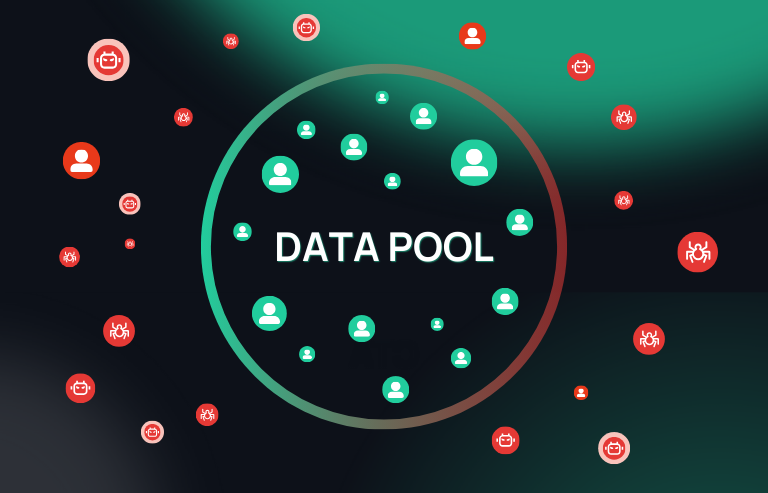- Products
- Integrations
- Plans
- Success Stories
- Resources
- Latest WhitepaperUnmasking the Shadows: Invalid Traffic 2024
Learn everything you need to know about Invalid Traffic in 2024 based on our customers’ data. Including a breakdown into marketing channels, industries and much more.
Resources
- Company
- Company
- Blog
Why AI surpasses traditional rule-based methods in bot detection

Oliver Kampmeier
Cybersecurity Content Specialist

In today’s interconnected digital world, bots represent both a marvel of technology and a significant threat to cybersecurity and companies’ ad budget. From automating simple tasks to simulating complex human interactions, bots have found their place in our digital ecosystem. Yet, as their numbers grow, distinguishing between benign and malicious bots has become increasingly imperative.
It is estimated that advertisers lose over $100 billion each year to ad fraud. In most cases, bots are used to siphon off a portion of the ad budget.
Traditional defenses against malicious bots have predominantly relied on rule-based detection approaches. These systems, governed by a fixed set of conditions, have been the bulwark against many conventional threats. But with the intricacy and dynamism of modern bot attacks, can they still hold their ground?
In this article, we’ll take a look into the mechanism of rule-based bot detection, understanding its strengths and inherent limitations. Furthermore, we take a look at why fraud0 uses Artificial Intelligence (AI) to detect bots and assess its potential to reshape our defense strategies against evolving bot threats.
Understanding traditional rule-based bot detection
In the age of rapidly evolving digital threats, it’s essential to understand the foundations of the methods we’ve traditionally relied upon. Rule-based bot detection stands as one of the cornerstones in this defense.
How rule-based bot detection works
At its core, rule-based detection operates on predefined sets of conditions or ‘rules’ established by cybersecurity experts. When incoming traffic or user behavior matches these conditions, an alert is triggered, signaling a potential threat. For instance, if an IP address tries to access a server too many times within a short period, it may be flagged as suspicious based on a set rule.
Strengths of rule-based bot detection
- Clear-cut parameters
Rule-based systems are transparent, making it easier for everybody to understand why a particular action was flagged. - Consistency
Since the rules are predefined, there is a consistency in detection. The same behavior will always yield the same response. - Quick implementation
For known threats, it’s often faster to establish a rule than to train a machine learning model.
Limitations of rule-based bot detection
- Static nature
The biggest drawback is its inability to adapt. As bot attacks evolve, rule-based systems can’t adjust unless manually updated. - Maintenance overhead
These systems require constant updates to stay relevant, necessitating regular manual intervention. This means that you are always in a reactive role and can only react when new attack patterns have established themselves. - Limitations in complexity
Rule-based bot detection can struggle to identify multifaceted or sophisticated attacks that don’t fit neatly into established rules. - False positives
A rigid rule might flag legitimate behavior as suspicious, causing valid human traffic to be classified as invalid or malicious. - Unidentified new threats
If a new type of attack doesn’t fit any existing rule, it will go undetected.
In the grand scheme of cybersecurity, rule-based detection served as a primary line of defense for many years. While it offered certain strengths, the dynamic nature of bot attacks soon exposed its inherent limitations. As we move forward, it’s clear that for a more comprehensive and adaptive solution, we need to turn to advanced technologies like AI.
Key benefits of using AI for bot detection
The nature of bots has transformed dramatically over the past years, demanding solutions beyond what traditional methods can offer. Enter Artificial Intelligence, a beacon of hope in this new age of cybersecurity. The main benefits of using AI for bot detection include:
- Dynamic adaptability and proactive detection
Traditional methods often play catch-up, modifying rules after new threats emerge. Instead of merely reacting to known threats, AI anticipates potential risks, predicting emerging threats based on historical and current data patterns without manual intervention. - Holistic analysis
Instead of evaluating threats isolated, AI looks at the broader context, understanding user behavior, network traffic, and other factors in tandem to make more informed decisions. - Real-time analysis
In the fast-paced digital arena, every second counts. AI processes vast amounts of data swiftly, ensuring threats are detected and mitigated in real-time. - Reduced false positives
Nothing disrupts security operations like a flurry of false alarms. AI, through its nuanced understanding of data, can drastically reduce these, ensuring that alerts are both relevant and actionable. - Scalability
As businesses grow and digital interactions multiply, AI systems seamlessly scale, ensuring consistent protection without overburdening infrastructures. - Continual learning
Cybersecurity is a moving target. AI’s ability to learn from every interaction – be it benign or malicious – means it becomes more effective over time. - Low maintenance
While no system is truly “set and forget”, AI dramatically reduces the need for frequent manual rule updates. As it learns, it refines its detection techniques autonomously. - Zero-day threat detection
The most dangerous threats are often the newest. AI’s strength lies in identifying anomalies, spotlighting unusual activities and detecting brand-new bot attacks that might not yet be documented.
As digital landscapes evolve, relying solely on traditional methods could leave systems and companies vulnerable. AI, with its array of benefits, presents a compelling case for being the gold standard in bot detection, melding adaptability with accuracy.
Navigating the future of bot detection
In our exploration of bot detection, we’ve journeyed from the well-trodden paths of traditional rule-based methods to the dynamic and promising terrain of AI-driven solutions. The contrast is palpable: from fixed and manual systems to those that are adaptive, predictive, and self-improving.
The rise of AI in cybersecurity isn’t just a technological advancement – it represents a paradigm shift. While rule-based systems have their merits and have served us well for years, the ever-evolving nature of digital threats necessitates a more robust and agile response. AI, with its intricate pattern recognition, predictive capabilities, and real-time adaptability, rises to this challenge. The payoff is immense: a more secure digital landscape, reduced false positives, and a proactive stance against new and emerging threats.
As we stand at this crossroad, looking ahead, the message is clear: To ensure a resilient and secure future, embracing the AI revolution in bot detection isn’t just advisable – it’s imperative. As businesses, organizations, and individuals, the time is ripe to lean into this change, steering our digital ships with AI as our compass, navigating the vast and often turbulent waters of the bot attacks.
From the beginning, fraud0 has relied on the power of AI alongside rule-based detection mechanisms. That’s why our system can detect and prevent many more attacks than traditional providers.
See our AI-powered bot detection for yourself and sign up for a free 7-day trial today. You’ll appreciate the value within no time.
- Published: August 23, 2023
- Updated: November 28, 2023

Learn everything you need to know about Invalid Traffic in 2024 based on our customers’ data. Including a breakdown into marketing channels, industries and much more.
1%, 4%, 36%?







